The Impact of Working Environment on Employee Performance Dissertation
VerifiedAdded on 2022/08/23
|42
|9309
|20
Project
AI Summary
This dissertation investigates the impact of the working environment on employee performance within Cash Financial Services Group Limited in Hong Kong. The study explores how various factors, including physical setup, hygiene, work culture, and training, affect employee productivity and satisfaction. Utilizing a mixed-methods approach, including questionnaires administered to 100 employees, the research analyzes demographic data and assesses the influence of workplace conditions on job output. The findings highlight challenges such as outdated facilities, inadequate training, and leadership issues, leading to employee dissatisfaction. The dissertation reviews relevant theories like Goal-Setting, Expectancy, and Maslow's Hierarchy of Needs, providing a comprehensive literature review and conceptual framework. It concludes with recommendations for improving the work environment and enhancing employee performance, addressing limitations and suggesting areas for future research. The study also includes a reflective account and critical review by the author.
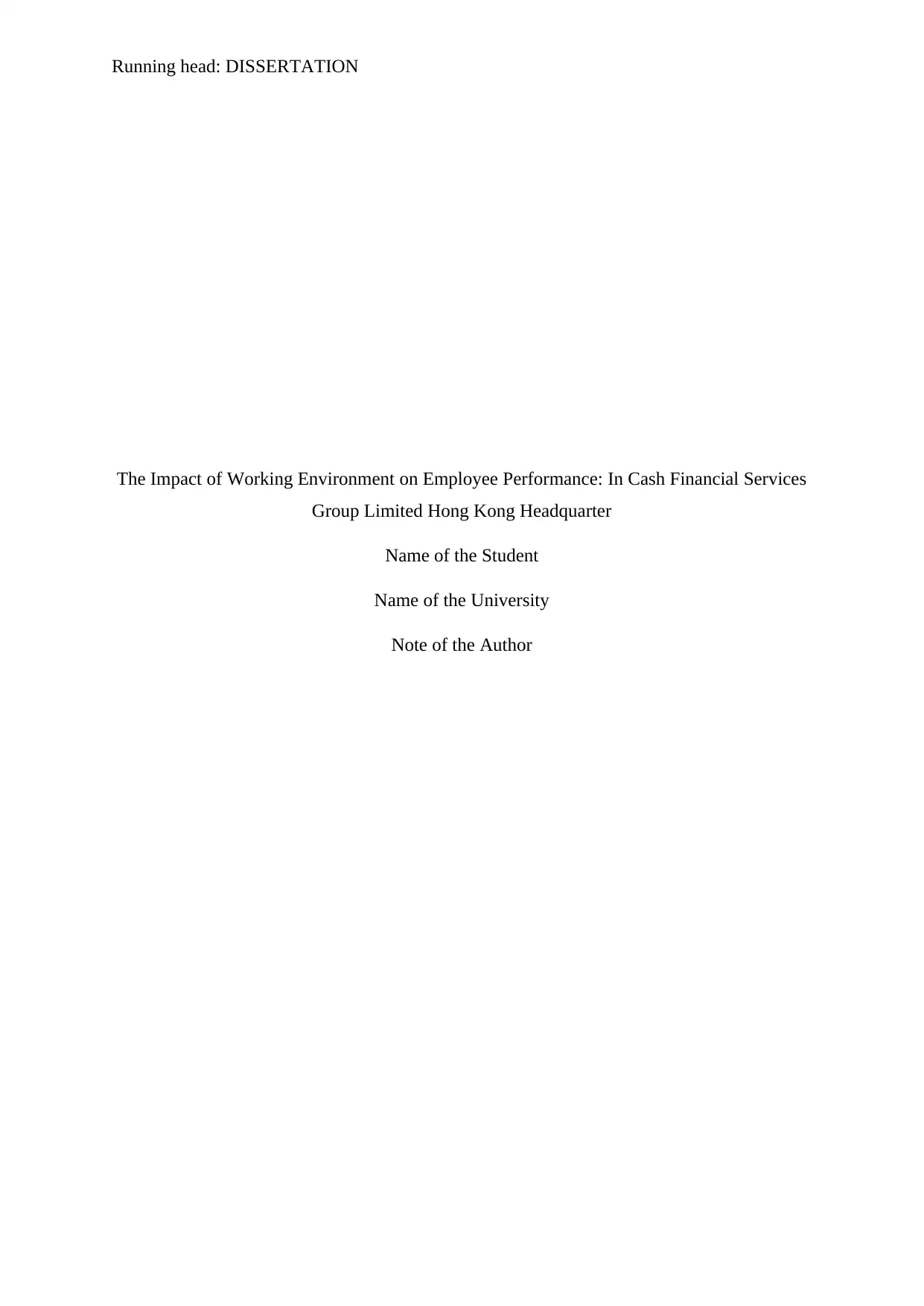
Running head: DISSERTATION
The Impact of Working Environment on Employee Performance: In Cash Financial Services
Group Limited Hong Kong Headquarter
Name of the Student
Name of the University
Note of the Author
The Impact of Working Environment on Employee Performance: In Cash Financial Services
Group Limited Hong Kong Headquarter
Name of the Student
Name of the University
Note of the Author
Paraphrase This Document
Need a fresh take? Get an instant paraphrase of this document with our AI Paraphraser
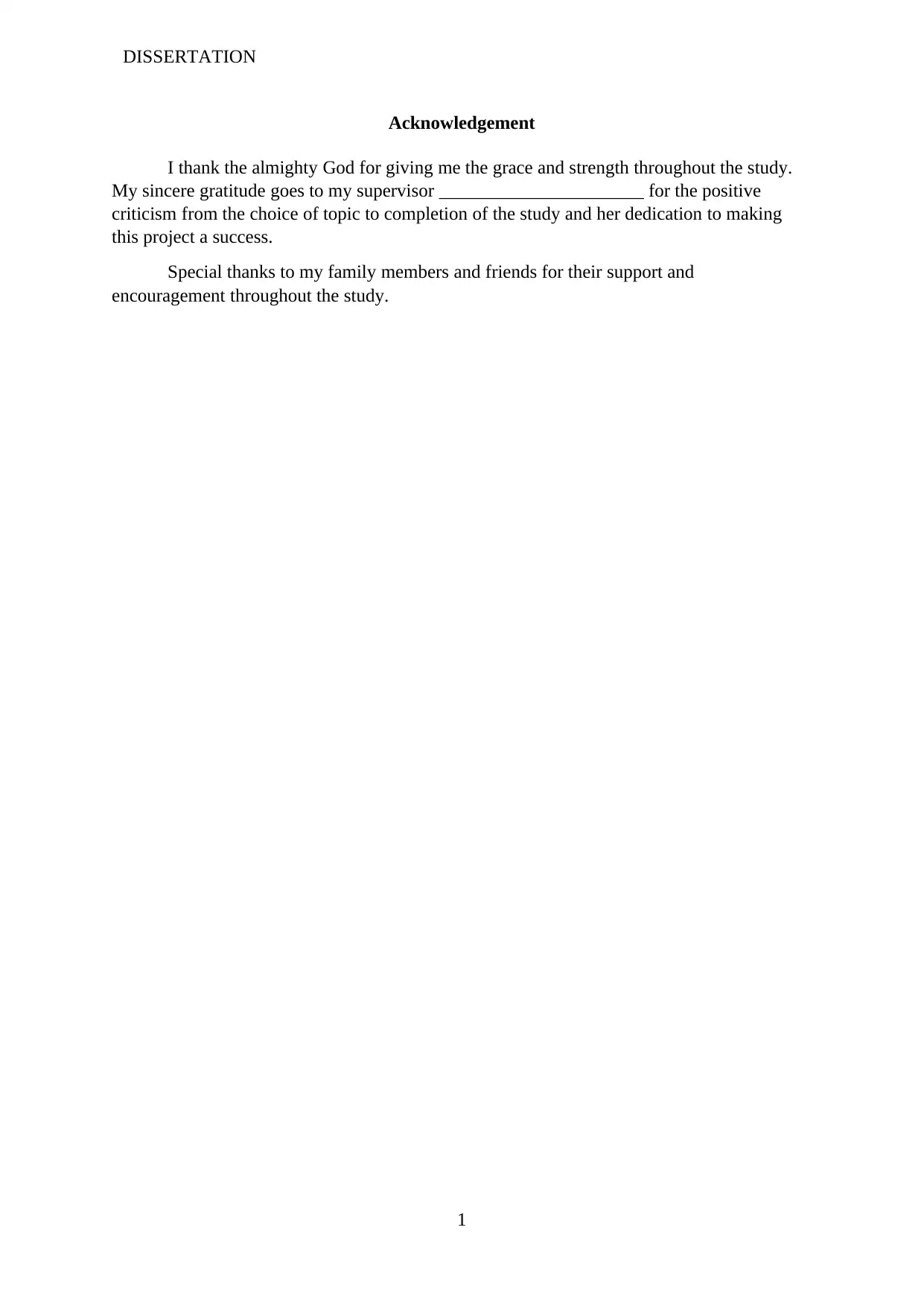
DISSERTATION
Acknowledgement
I thank the almighty God for giving me the grace and strength throughout the study.
My sincere gratitude goes to my supervisor ______________________ for the positive
criticism from the choice of topic to completion of the study and her dedication to making
this project a success.
Special thanks to my family members and friends for their support and
encouragement throughout the study.
1
Acknowledgement
I thank the almighty God for giving me the grace and strength throughout the study.
My sincere gratitude goes to my supervisor ______________________ for the positive
criticism from the choice of topic to completion of the study and her dedication to making
this project a success.
Special thanks to my family members and friends for their support and
encouragement throughout the study.
1
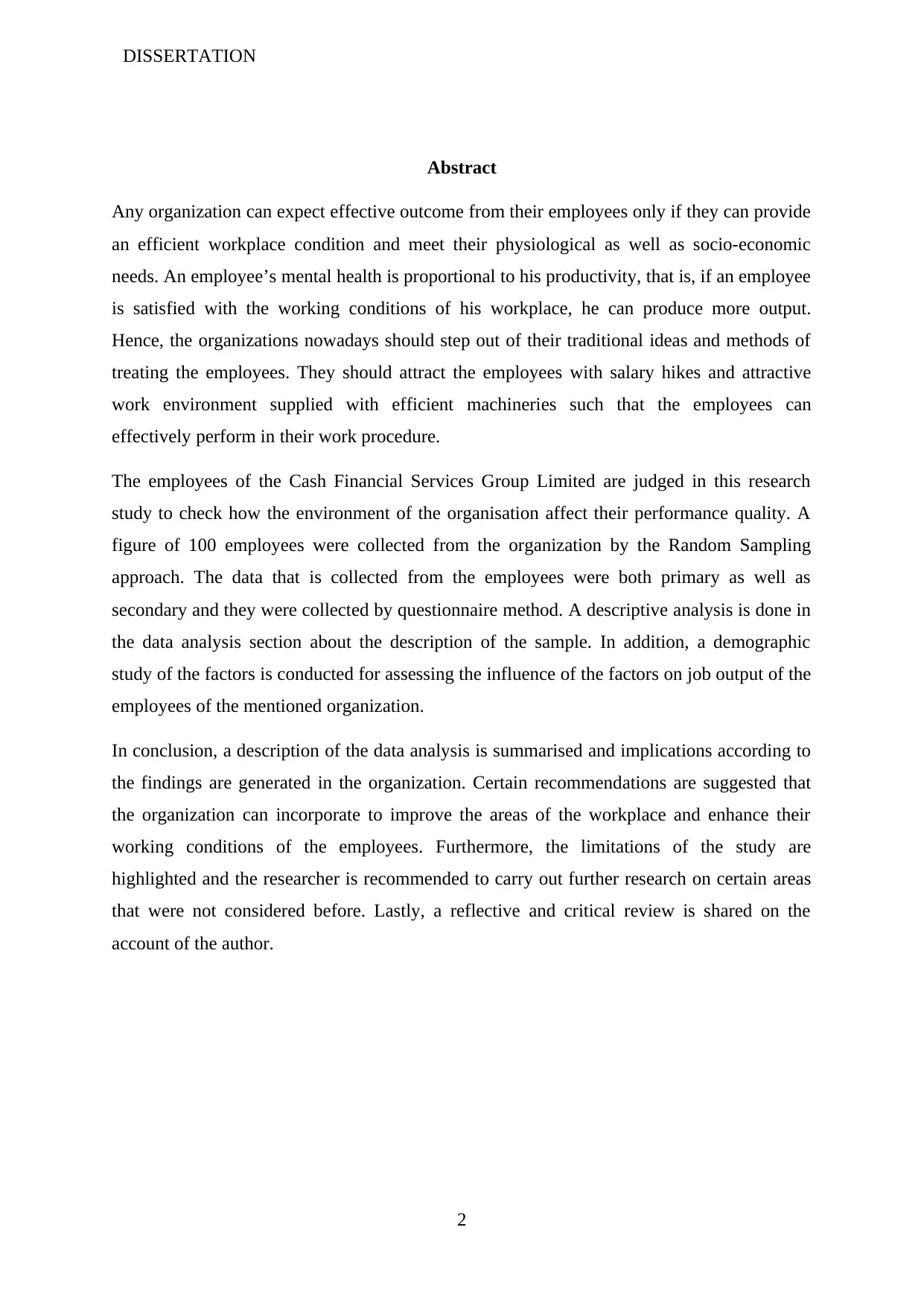
DISSERTATION
Abstract
Any organization can expect effective outcome from their employees only if they can provide
an efficient workplace condition and meet their physiological as well as socio-economic
needs. An employee’s mental health is proportional to his productivity, that is, if an employee
is satisfied with the working conditions of his workplace, he can produce more output.
Hence, the organizations nowadays should step out of their traditional ideas and methods of
treating the employees. They should attract the employees with salary hikes and attractive
work environment supplied with efficient machineries such that the employees can
effectively perform in their work procedure.
The employees of the Cash Financial Services Group Limited are judged in this research
study to check how the environment of the organisation affect their performance quality. A
figure of 100 employees were collected from the organization by the Random Sampling
approach. The data that is collected from the employees were both primary as well as
secondary and they were collected by questionnaire method. A descriptive analysis is done in
the data analysis section about the description of the sample. In addition, a demographic
study of the factors is conducted for assessing the influence of the factors on job output of the
employees of the mentioned organization.
In conclusion, a description of the data analysis is summarised and implications according to
the findings are generated in the organization. Certain recommendations are suggested that
the organization can incorporate to improve the areas of the workplace and enhance their
working conditions of the employees. Furthermore, the limitations of the study are
highlighted and the researcher is recommended to carry out further research on certain areas
that were not considered before. Lastly, a reflective and critical review is shared on the
account of the author.
2
Abstract
Any organization can expect effective outcome from their employees only if they can provide
an efficient workplace condition and meet their physiological as well as socio-economic
needs. An employee’s mental health is proportional to his productivity, that is, if an employee
is satisfied with the working conditions of his workplace, he can produce more output.
Hence, the organizations nowadays should step out of their traditional ideas and methods of
treating the employees. They should attract the employees with salary hikes and attractive
work environment supplied with efficient machineries such that the employees can
effectively perform in their work procedure.
The employees of the Cash Financial Services Group Limited are judged in this research
study to check how the environment of the organisation affect their performance quality. A
figure of 100 employees were collected from the organization by the Random Sampling
approach. The data that is collected from the employees were both primary as well as
secondary and they were collected by questionnaire method. A descriptive analysis is done in
the data analysis section about the description of the sample. In addition, a demographic
study of the factors is conducted for assessing the influence of the factors on job output of the
employees of the mentioned organization.
In conclusion, a description of the data analysis is summarised and implications according to
the findings are generated in the organization. Certain recommendations are suggested that
the organization can incorporate to improve the areas of the workplace and enhance their
working conditions of the employees. Furthermore, the limitations of the study are
highlighted and the researcher is recommended to carry out further research on certain areas
that were not considered before. Lastly, a reflective and critical review is shared on the
account of the author.
2
⊘ This is a preview!⊘
Do you want full access?
Subscribe today to unlock all pages.

Trusted by 1+ million students worldwide
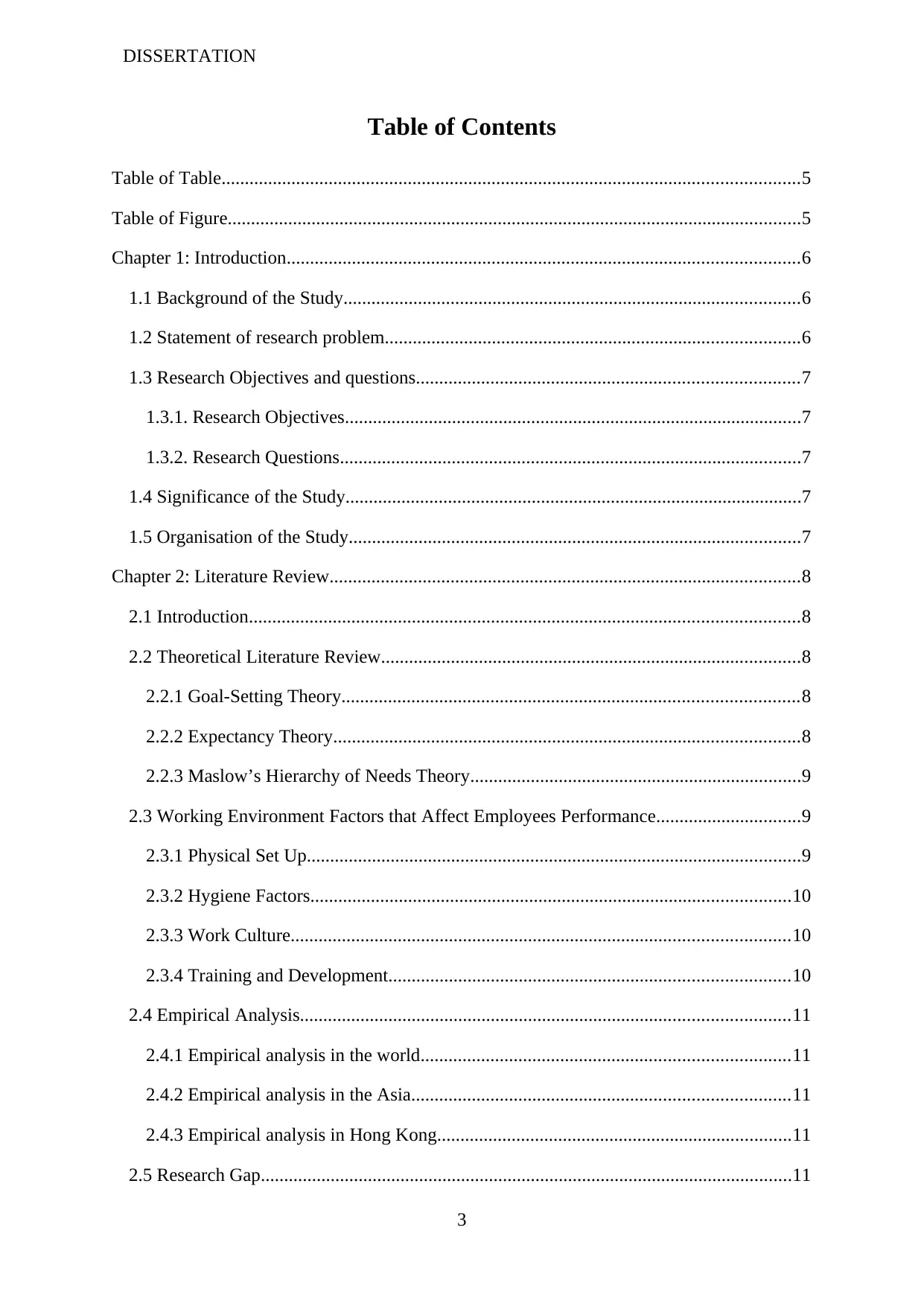
DISSERTATION
Table of Contents
Table of Table............................................................................................................................5
Table of Figure...........................................................................................................................5
Chapter 1: Introduction..............................................................................................................6
1.1 Background of the Study..................................................................................................6
1.2 Statement of research problem.........................................................................................6
1.3 Research Objectives and questions..................................................................................7
1.3.1. Research Objectives..................................................................................................7
1.3.2. Research Questions...................................................................................................7
1.4 Significance of the Study..................................................................................................7
1.5 Organisation of the Study.................................................................................................7
Chapter 2: Literature Review.....................................................................................................8
2.1 Introduction......................................................................................................................8
2.2 Theoretical Literature Review..........................................................................................8
2.2.1 Goal-Setting Theory..................................................................................................8
2.2.2 Expectancy Theory....................................................................................................8
2.2.3 Maslow’s Hierarchy of Needs Theory.......................................................................9
2.3 Working Environment Factors that Affect Employees Performance...............................9
2.3.1 Physical Set Up..........................................................................................................9
2.3.2 Hygiene Factors.......................................................................................................10
2.3.3 Work Culture...........................................................................................................10
2.3.4 Training and Development......................................................................................10
2.4 Empirical Analysis.........................................................................................................11
2.4.1 Empirical analysis in the world...............................................................................11
2.4.2 Empirical analysis in the Asia.................................................................................11
2.4.3 Empirical analysis in Hong Kong............................................................................11
2.5 Research Gap..................................................................................................................11
3
Table of Contents
Table of Table............................................................................................................................5
Table of Figure...........................................................................................................................5
Chapter 1: Introduction..............................................................................................................6
1.1 Background of the Study..................................................................................................6
1.2 Statement of research problem.........................................................................................6
1.3 Research Objectives and questions..................................................................................7
1.3.1. Research Objectives..................................................................................................7
1.3.2. Research Questions...................................................................................................7
1.4 Significance of the Study..................................................................................................7
1.5 Organisation of the Study.................................................................................................7
Chapter 2: Literature Review.....................................................................................................8
2.1 Introduction......................................................................................................................8
2.2 Theoretical Literature Review..........................................................................................8
2.2.1 Goal-Setting Theory..................................................................................................8
2.2.2 Expectancy Theory....................................................................................................8
2.2.3 Maslow’s Hierarchy of Needs Theory.......................................................................9
2.3 Working Environment Factors that Affect Employees Performance...............................9
2.3.1 Physical Set Up..........................................................................................................9
2.3.2 Hygiene Factors.......................................................................................................10
2.3.3 Work Culture...........................................................................................................10
2.3.4 Training and Development......................................................................................10
2.4 Empirical Analysis.........................................................................................................11
2.4.1 Empirical analysis in the world...............................................................................11
2.4.2 Empirical analysis in the Asia.................................................................................11
2.4.3 Empirical analysis in Hong Kong............................................................................11
2.5 Research Gap..................................................................................................................11
3
Paraphrase This Document
Need a fresh take? Get an instant paraphrase of this document with our AI Paraphraser
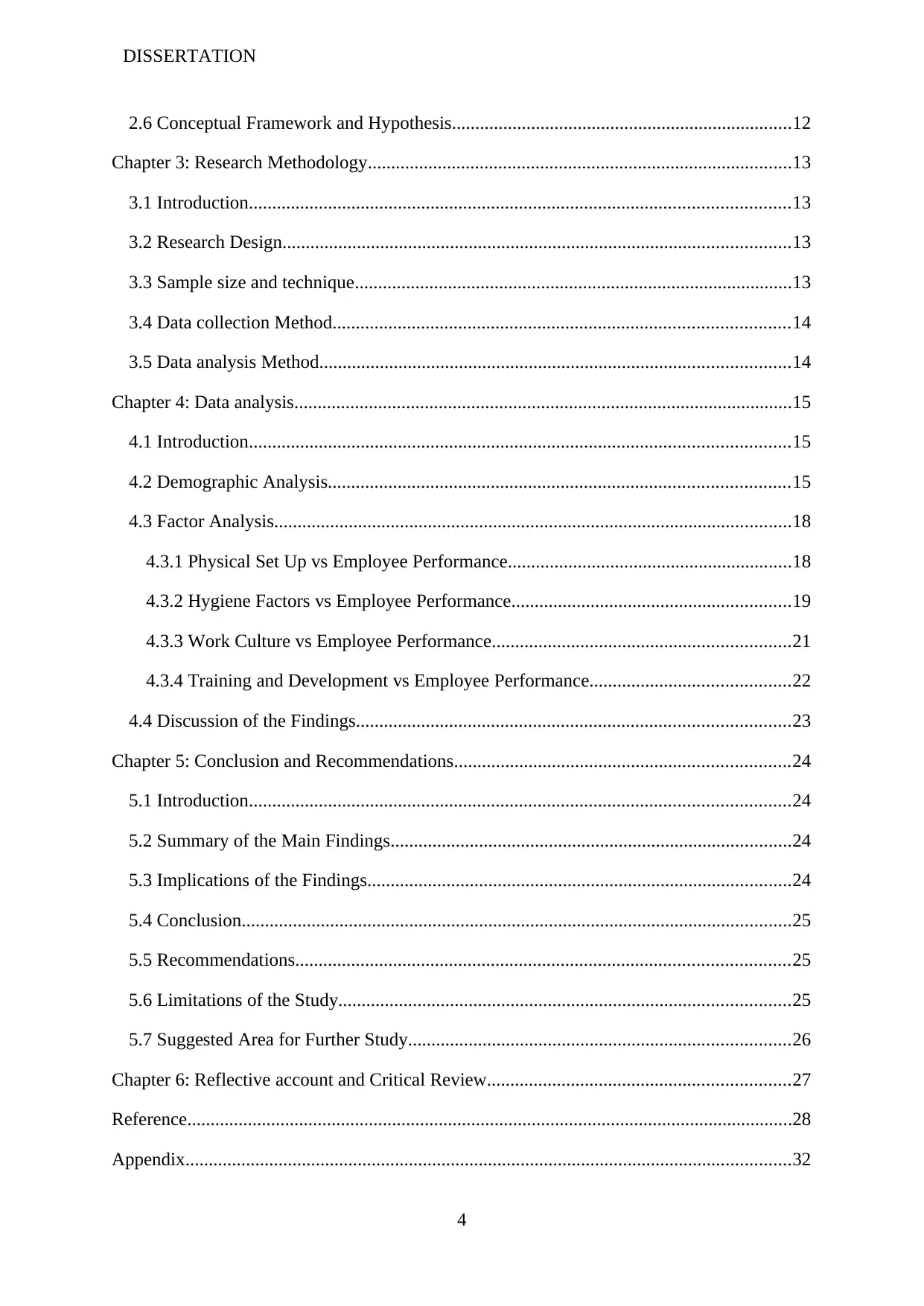
DISSERTATION
2.6 Conceptual Framework and Hypothesis.........................................................................12
Chapter 3: Research Methodology...........................................................................................13
3.1 Introduction....................................................................................................................13
3.2 Research Design.............................................................................................................13
3.3 Sample size and technique..............................................................................................13
3.4 Data collection Method..................................................................................................14
3.5 Data analysis Method.....................................................................................................14
Chapter 4: Data analysis...........................................................................................................15
4.1 Introduction....................................................................................................................15
4.2 Demographic Analysis...................................................................................................15
4.3 Factor Analysis...............................................................................................................18
4.3.1 Physical Set Up vs Employee Performance.............................................................18
4.3.2 Hygiene Factors vs Employee Performance............................................................19
4.3.3 Work Culture vs Employee Performance................................................................21
4.3.4 Training and Development vs Employee Performance...........................................22
4.4 Discussion of the Findings.............................................................................................23
Chapter 5: Conclusion and Recommendations........................................................................24
5.1 Introduction....................................................................................................................24
5.2 Summary of the Main Findings......................................................................................24
5.3 Implications of the Findings...........................................................................................24
5.4 Conclusion......................................................................................................................25
5.5 Recommendations..........................................................................................................25
5.6 Limitations of the Study.................................................................................................25
5.7 Suggested Area for Further Study..................................................................................26
Chapter 6: Reflective account and Critical Review.................................................................27
Reference..................................................................................................................................28
Appendix..................................................................................................................................32
4
2.6 Conceptual Framework and Hypothesis.........................................................................12
Chapter 3: Research Methodology...........................................................................................13
3.1 Introduction....................................................................................................................13
3.2 Research Design.............................................................................................................13
3.3 Sample size and technique..............................................................................................13
3.4 Data collection Method..................................................................................................14
3.5 Data analysis Method.....................................................................................................14
Chapter 4: Data analysis...........................................................................................................15
4.1 Introduction....................................................................................................................15
4.2 Demographic Analysis...................................................................................................15
4.3 Factor Analysis...............................................................................................................18
4.3.1 Physical Set Up vs Employee Performance.............................................................18
4.3.2 Hygiene Factors vs Employee Performance............................................................19
4.3.3 Work Culture vs Employee Performance................................................................21
4.3.4 Training and Development vs Employee Performance...........................................22
4.4 Discussion of the Findings.............................................................................................23
Chapter 5: Conclusion and Recommendations........................................................................24
5.1 Introduction....................................................................................................................24
5.2 Summary of the Main Findings......................................................................................24
5.3 Implications of the Findings...........................................................................................24
5.4 Conclusion......................................................................................................................25
5.5 Recommendations..........................................................................................................25
5.6 Limitations of the Study.................................................................................................25
5.7 Suggested Area for Further Study..................................................................................26
Chapter 6: Reflective account and Critical Review.................................................................27
Reference..................................................................................................................................28
Appendix..................................................................................................................................32
4
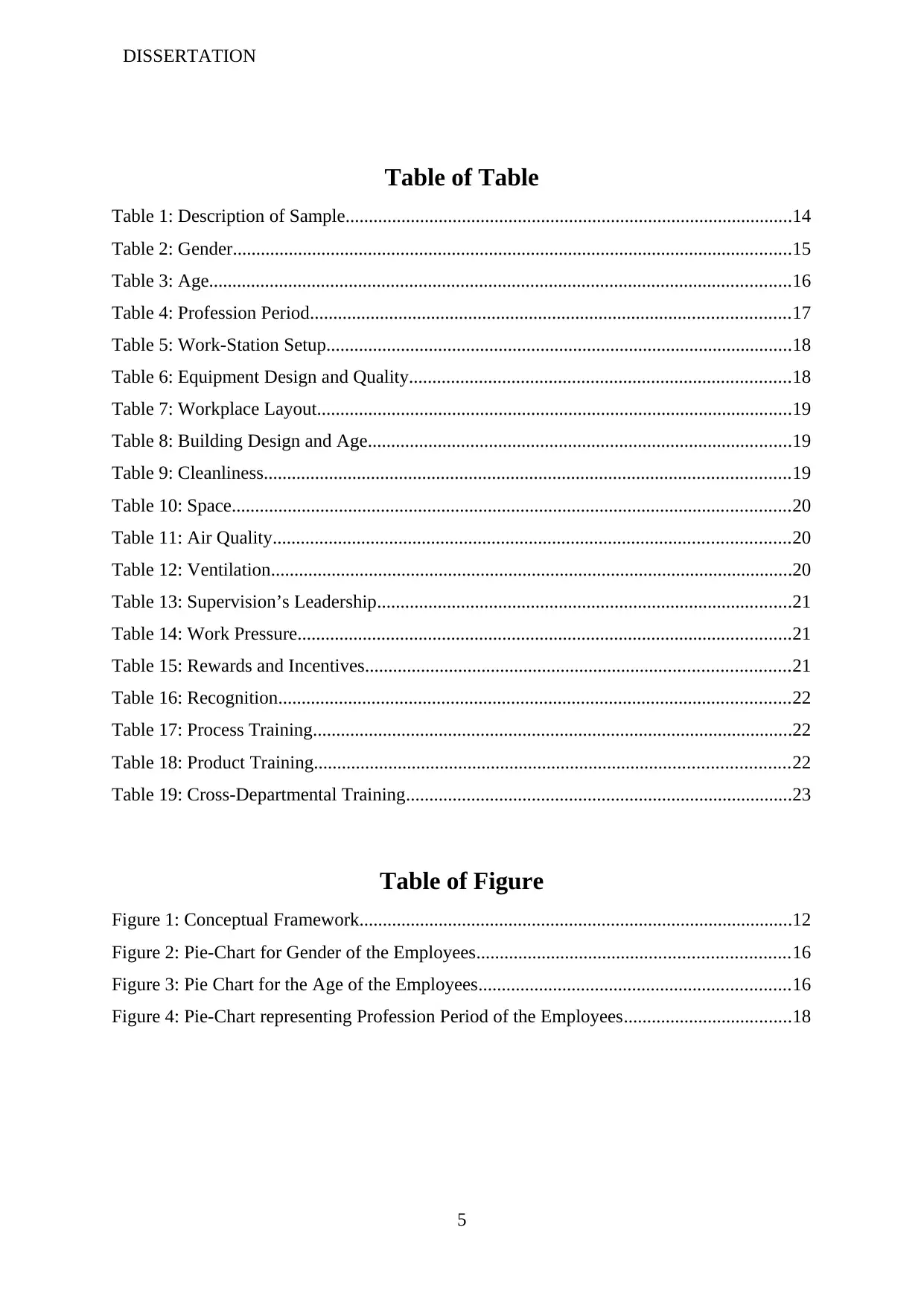
DISSERTATION
Table of Table
Table 1: Description of Sample................................................................................................14
Table 2: Gender........................................................................................................................15
Table 3: Age.............................................................................................................................16
Table 4: Profession Period.......................................................................................................17
Table 5: Work-Station Setup....................................................................................................18
Table 6: Equipment Design and Quality..................................................................................18
Table 7: Workplace Layout......................................................................................................19
Table 8: Building Design and Age...........................................................................................19
Table 9: Cleanliness.................................................................................................................19
Table 10: Space........................................................................................................................20
Table 11: Air Quality...............................................................................................................20
Table 12: Ventilation................................................................................................................20
Table 13: Supervision’s Leadership.........................................................................................21
Table 14: Work Pressure..........................................................................................................21
Table 15: Rewards and Incentives...........................................................................................21
Table 16: Recognition..............................................................................................................22
Table 17: Process Training.......................................................................................................22
Table 18: Product Training......................................................................................................22
Table 19: Cross-Departmental Training...................................................................................23
Table of Figure
Figure 1: Conceptual Framework.............................................................................................12
Figure 2: Pie-Chart for Gender of the Employees...................................................................16
Figure 3: Pie Chart for the Age of the Employees...................................................................16
Figure 4: Pie-Chart representing Profession Period of the Employees....................................18
5
Table of Table
Table 1: Description of Sample................................................................................................14
Table 2: Gender........................................................................................................................15
Table 3: Age.............................................................................................................................16
Table 4: Profession Period.......................................................................................................17
Table 5: Work-Station Setup....................................................................................................18
Table 6: Equipment Design and Quality..................................................................................18
Table 7: Workplace Layout......................................................................................................19
Table 8: Building Design and Age...........................................................................................19
Table 9: Cleanliness.................................................................................................................19
Table 10: Space........................................................................................................................20
Table 11: Air Quality...............................................................................................................20
Table 12: Ventilation................................................................................................................20
Table 13: Supervision’s Leadership.........................................................................................21
Table 14: Work Pressure..........................................................................................................21
Table 15: Rewards and Incentives...........................................................................................21
Table 16: Recognition..............................................................................................................22
Table 17: Process Training.......................................................................................................22
Table 18: Product Training......................................................................................................22
Table 19: Cross-Departmental Training...................................................................................23
Table of Figure
Figure 1: Conceptual Framework.............................................................................................12
Figure 2: Pie-Chart for Gender of the Employees...................................................................16
Figure 3: Pie Chart for the Age of the Employees...................................................................16
Figure 4: Pie-Chart representing Profession Period of the Employees....................................18
5
⊘ This is a preview!⊘
Do you want full access?
Subscribe today to unlock all pages.

Trusted by 1+ million students worldwide
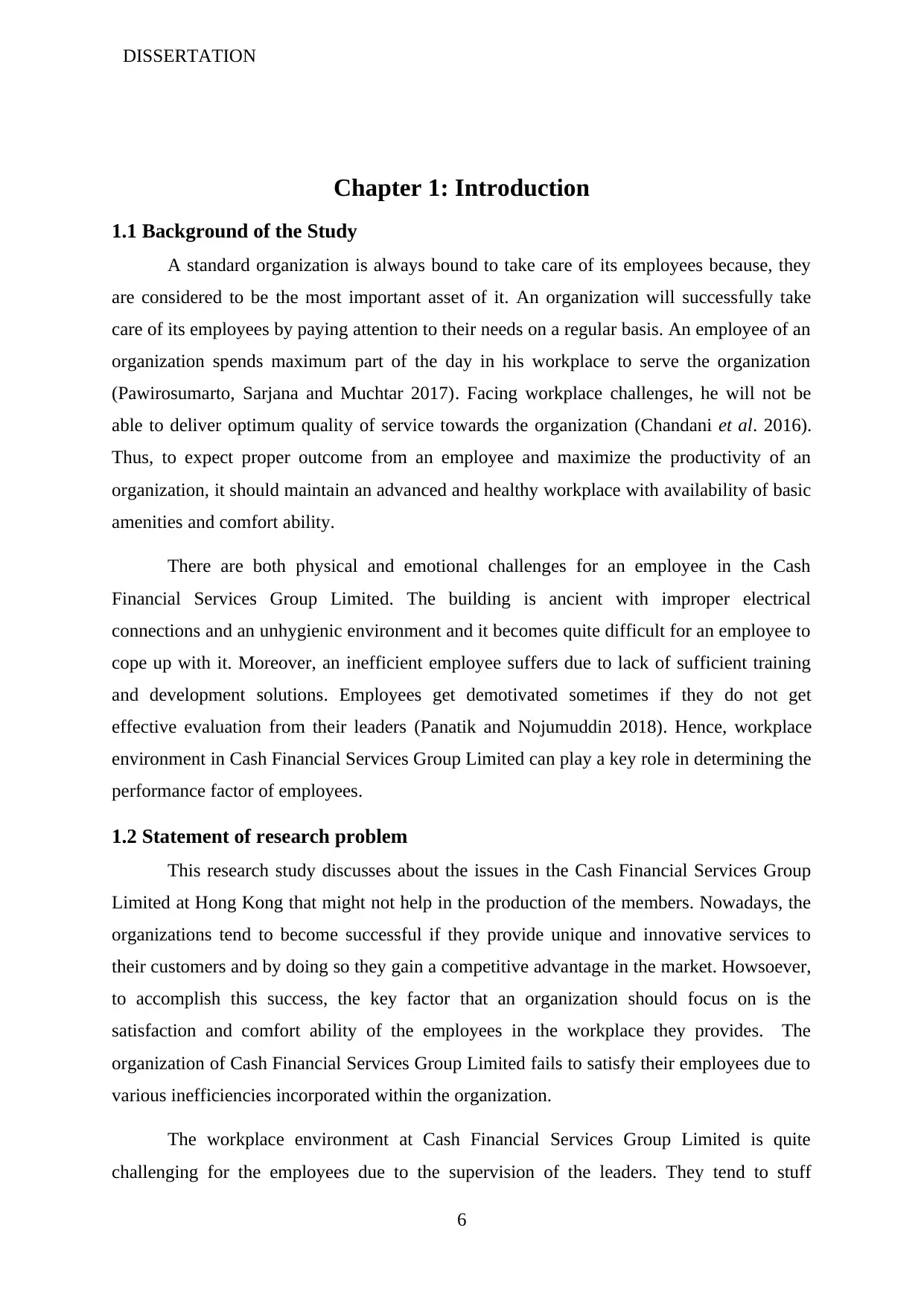
DISSERTATION
Chapter 1: Introduction
1.1 Background of the Study
A standard organization is always bound to take care of its employees because, they
are considered to be the most important asset of it. An organization will successfully take
care of its employees by paying attention to their needs on a regular basis. An employee of an
organization spends maximum part of the day in his workplace to serve the organization
(Pawirosumarto, Sarjana and Muchtar 2017). Facing workplace challenges, he will not be
able to deliver optimum quality of service towards the organization (Chandani et al. 2016).
Thus, to expect proper outcome from an employee and maximize the productivity of an
organization, it should maintain an advanced and healthy workplace with availability of basic
amenities and comfort ability.
There are both physical and emotional challenges for an employee in the Cash
Financial Services Group Limited. The building is ancient with improper electrical
connections and an unhygienic environment and it becomes quite difficult for an employee to
cope up with it. Moreover, an inefficient employee suffers due to lack of sufficient training
and development solutions. Employees get demotivated sometimes if they do not get
effective evaluation from their leaders (Panatik and Nojumuddin 2018). Hence, workplace
environment in Cash Financial Services Group Limited can play a key role in determining the
performance factor of employees.
1.2 Statement of research problem
This research study discusses about the issues in the Cash Financial Services Group
Limited at Hong Kong that might not help in the production of the members. Nowadays, the
organizations tend to become successful if they provide unique and innovative services to
their customers and by doing so they gain a competitive advantage in the market. Howsoever,
to accomplish this success, the key factor that an organization should focus on is the
satisfaction and comfort ability of the employees in the workplace they provides. The
organization of Cash Financial Services Group Limited fails to satisfy their employees due to
various inefficiencies incorporated within the organization.
The workplace environment at Cash Financial Services Group Limited is quite
challenging for the employees due to the supervision of the leaders. They tend to stuff
6
Chapter 1: Introduction
1.1 Background of the Study
A standard organization is always bound to take care of its employees because, they
are considered to be the most important asset of it. An organization will successfully take
care of its employees by paying attention to their needs on a regular basis. An employee of an
organization spends maximum part of the day in his workplace to serve the organization
(Pawirosumarto, Sarjana and Muchtar 2017). Facing workplace challenges, he will not be
able to deliver optimum quality of service towards the organization (Chandani et al. 2016).
Thus, to expect proper outcome from an employee and maximize the productivity of an
organization, it should maintain an advanced and healthy workplace with availability of basic
amenities and comfort ability.
There are both physical and emotional challenges for an employee in the Cash
Financial Services Group Limited. The building is ancient with improper electrical
connections and an unhygienic environment and it becomes quite difficult for an employee to
cope up with it. Moreover, an inefficient employee suffers due to lack of sufficient training
and development solutions. Employees get demotivated sometimes if they do not get
effective evaluation from their leaders (Panatik and Nojumuddin 2018). Hence, workplace
environment in Cash Financial Services Group Limited can play a key role in determining the
performance factor of employees.
1.2 Statement of research problem
This research study discusses about the issues in the Cash Financial Services Group
Limited at Hong Kong that might not help in the production of the members. Nowadays, the
organizations tend to become successful if they provide unique and innovative services to
their customers and by doing so they gain a competitive advantage in the market. Howsoever,
to accomplish this success, the key factor that an organization should focus on is the
satisfaction and comfort ability of the employees in the workplace they provides. The
organization of Cash Financial Services Group Limited fails to satisfy their employees due to
various inefficiencies incorporated within the organization.
The workplace environment at Cash Financial Services Group Limited is quite
challenging for the employees due to the supervision of the leaders. They tend to stuff
6
Paraphrase This Document
Need a fresh take? Get an instant paraphrase of this document with our AI Paraphraser
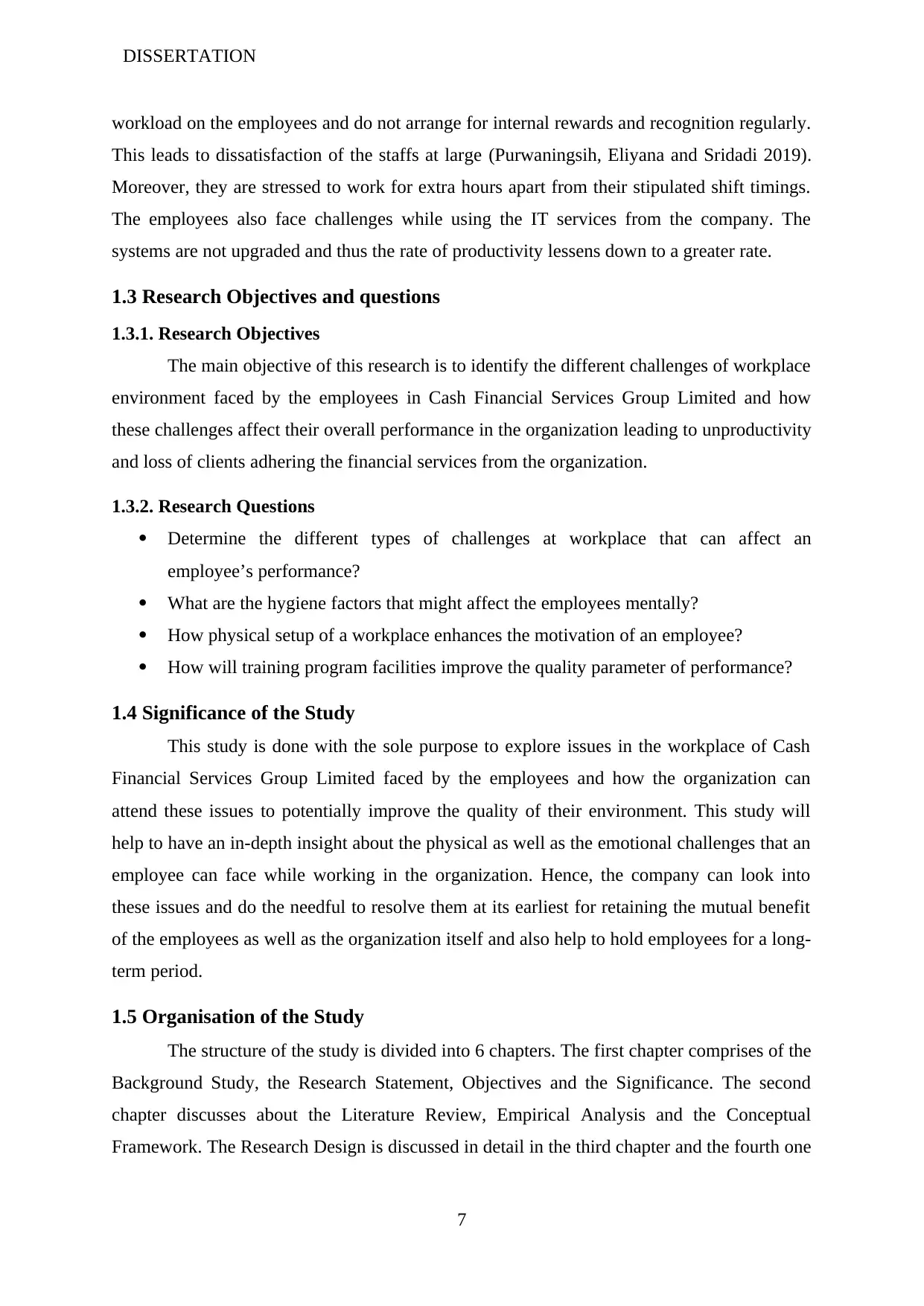
DISSERTATION
workload on the employees and do not arrange for internal rewards and recognition regularly.
This leads to dissatisfaction of the staffs at large (Purwaningsih, Eliyana and Sridadi 2019).
Moreover, they are stressed to work for extra hours apart from their stipulated shift timings.
The employees also face challenges while using the IT services from the company. The
systems are not upgraded and thus the rate of productivity lessens down to a greater rate.
1.3 Research Objectives and questions
1.3.1. Research Objectives
The main objective of this research is to identify the different challenges of workplace
environment faced by the employees in Cash Financial Services Group Limited and how
these challenges affect their overall performance in the organization leading to unproductivity
and loss of clients adhering the financial services from the organization.
1.3.2. Research Questions
Determine the different types of challenges at workplace that can affect an
employee’s performance?
What are the hygiene factors that might affect the employees mentally?
How physical setup of a workplace enhances the motivation of an employee?
How will training program facilities improve the quality parameter of performance?
1.4 Significance of the Study
This study is done with the sole purpose to explore issues in the workplace of Cash
Financial Services Group Limited faced by the employees and how the organization can
attend these issues to potentially improve the quality of their environment. This study will
help to have an in-depth insight about the physical as well as the emotional challenges that an
employee can face while working in the organization. Hence, the company can look into
these issues and do the needful to resolve them at its earliest for retaining the mutual benefit
of the employees as well as the organization itself and also help to hold employees for a long-
term period.
1.5 Organisation of the Study
The structure of the study is divided into 6 chapters. The first chapter comprises of the
Background Study, the Research Statement, Objectives and the Significance. The second
chapter discusses about the Literature Review, Empirical Analysis and the Conceptual
Framework. The Research Design is discussed in detail in the third chapter and the fourth one
7
workload on the employees and do not arrange for internal rewards and recognition regularly.
This leads to dissatisfaction of the staffs at large (Purwaningsih, Eliyana and Sridadi 2019).
Moreover, they are stressed to work for extra hours apart from their stipulated shift timings.
The employees also face challenges while using the IT services from the company. The
systems are not upgraded and thus the rate of productivity lessens down to a greater rate.
1.3 Research Objectives and questions
1.3.1. Research Objectives
The main objective of this research is to identify the different challenges of workplace
environment faced by the employees in Cash Financial Services Group Limited and how
these challenges affect their overall performance in the organization leading to unproductivity
and loss of clients adhering the financial services from the organization.
1.3.2. Research Questions
Determine the different types of challenges at workplace that can affect an
employee’s performance?
What are the hygiene factors that might affect the employees mentally?
How physical setup of a workplace enhances the motivation of an employee?
How will training program facilities improve the quality parameter of performance?
1.4 Significance of the Study
This study is done with the sole purpose to explore issues in the workplace of Cash
Financial Services Group Limited faced by the employees and how the organization can
attend these issues to potentially improve the quality of their environment. This study will
help to have an in-depth insight about the physical as well as the emotional challenges that an
employee can face while working in the organization. Hence, the company can look into
these issues and do the needful to resolve them at its earliest for retaining the mutual benefit
of the employees as well as the organization itself and also help to hold employees for a long-
term period.
1.5 Organisation of the Study
The structure of the study is divided into 6 chapters. The first chapter comprises of the
Background Study, the Research Statement, Objectives and the Significance. The second
chapter discusses about the Literature Review, Empirical Analysis and the Conceptual
Framework. The Research Design is discussed in detail in the third chapter and the fourth one
7
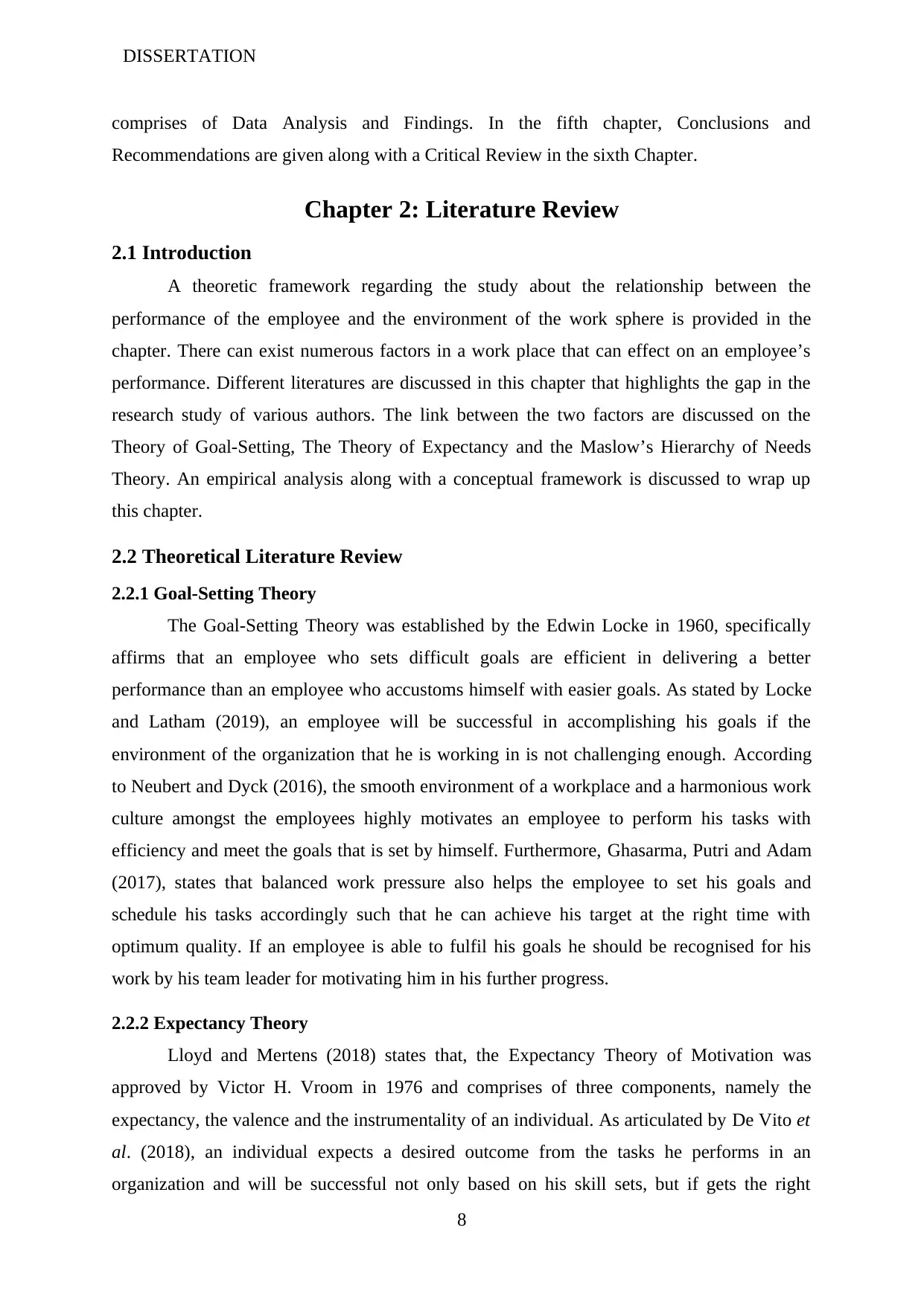
DISSERTATION
comprises of Data Analysis and Findings. In the fifth chapter, Conclusions and
Recommendations are given along with a Critical Review in the sixth Chapter.
Chapter 2: Literature Review
2.1 Introduction
A theoretic framework regarding the study about the relationship between the
performance of the employee and the environment of the work sphere is provided in the
chapter. There can exist numerous factors in a work place that can effect on an employee’s
performance. Different literatures are discussed in this chapter that highlights the gap in the
research study of various authors. The link between the two factors are discussed on the
Theory of Goal-Setting, The Theory of Expectancy and the Maslow’s Hierarchy of Needs
Theory. An empirical analysis along with a conceptual framework is discussed to wrap up
this chapter.
2.2 Theoretical Literature Review
2.2.1 Goal-Setting Theory
The Goal-Setting Theory was established by the Edwin Locke in 1960, specifically
affirms that an employee who sets difficult goals are efficient in delivering a better
performance than an employee who accustoms himself with easier goals. As stated by Locke
and Latham (2019), an employee will be successful in accomplishing his goals if the
environment of the organization that he is working in is not challenging enough. According
to Neubert and Dyck (2016), the smooth environment of a workplace and a harmonious work
culture amongst the employees highly motivates an employee to perform his tasks with
efficiency and meet the goals that is set by himself. Furthermore, Ghasarma, Putri and Adam
(2017), states that balanced work pressure also helps the employee to set his goals and
schedule his tasks accordingly such that he can achieve his target at the right time with
optimum quality. If an employee is able to fulfil his goals he should be recognised for his
work by his team leader for motivating him in his further progress.
2.2.2 Expectancy Theory
Lloyd and Mertens (2018) states that, the Expectancy Theory of Motivation was
approved by Victor H. Vroom in 1976 and comprises of three components, namely the
expectancy, the valence and the instrumentality of an individual. As articulated by De Vito et
al. (2018), an individual expects a desired outcome from the tasks he performs in an
organization and will be successful not only based on his skill sets, but if gets the right
8
comprises of Data Analysis and Findings. In the fifth chapter, Conclusions and
Recommendations are given along with a Critical Review in the sixth Chapter.
Chapter 2: Literature Review
2.1 Introduction
A theoretic framework regarding the study about the relationship between the
performance of the employee and the environment of the work sphere is provided in the
chapter. There can exist numerous factors in a work place that can effect on an employee’s
performance. Different literatures are discussed in this chapter that highlights the gap in the
research study of various authors. The link between the two factors are discussed on the
Theory of Goal-Setting, The Theory of Expectancy and the Maslow’s Hierarchy of Needs
Theory. An empirical analysis along with a conceptual framework is discussed to wrap up
this chapter.
2.2 Theoretical Literature Review
2.2.1 Goal-Setting Theory
The Goal-Setting Theory was established by the Edwin Locke in 1960, specifically
affirms that an employee who sets difficult goals are efficient in delivering a better
performance than an employee who accustoms himself with easier goals. As stated by Locke
and Latham (2019), an employee will be successful in accomplishing his goals if the
environment of the organization that he is working in is not challenging enough. According
to Neubert and Dyck (2016), the smooth environment of a workplace and a harmonious work
culture amongst the employees highly motivates an employee to perform his tasks with
efficiency and meet the goals that is set by himself. Furthermore, Ghasarma, Putri and Adam
(2017), states that balanced work pressure also helps the employee to set his goals and
schedule his tasks accordingly such that he can achieve his target at the right time with
optimum quality. If an employee is able to fulfil his goals he should be recognised for his
work by his team leader for motivating him in his further progress.
2.2.2 Expectancy Theory
Lloyd and Mertens (2018) states that, the Expectancy Theory of Motivation was
approved by Victor H. Vroom in 1976 and comprises of three components, namely the
expectancy, the valence and the instrumentality of an individual. As articulated by De Vito et
al. (2018), an individual expects a desired outcome from the tasks he performs in an
organization and will be successful not only based on his skill sets, but if gets the right
8
⊘ This is a preview!⊘
Do you want full access?
Subscribe today to unlock all pages.

Trusted by 1+ million students worldwide
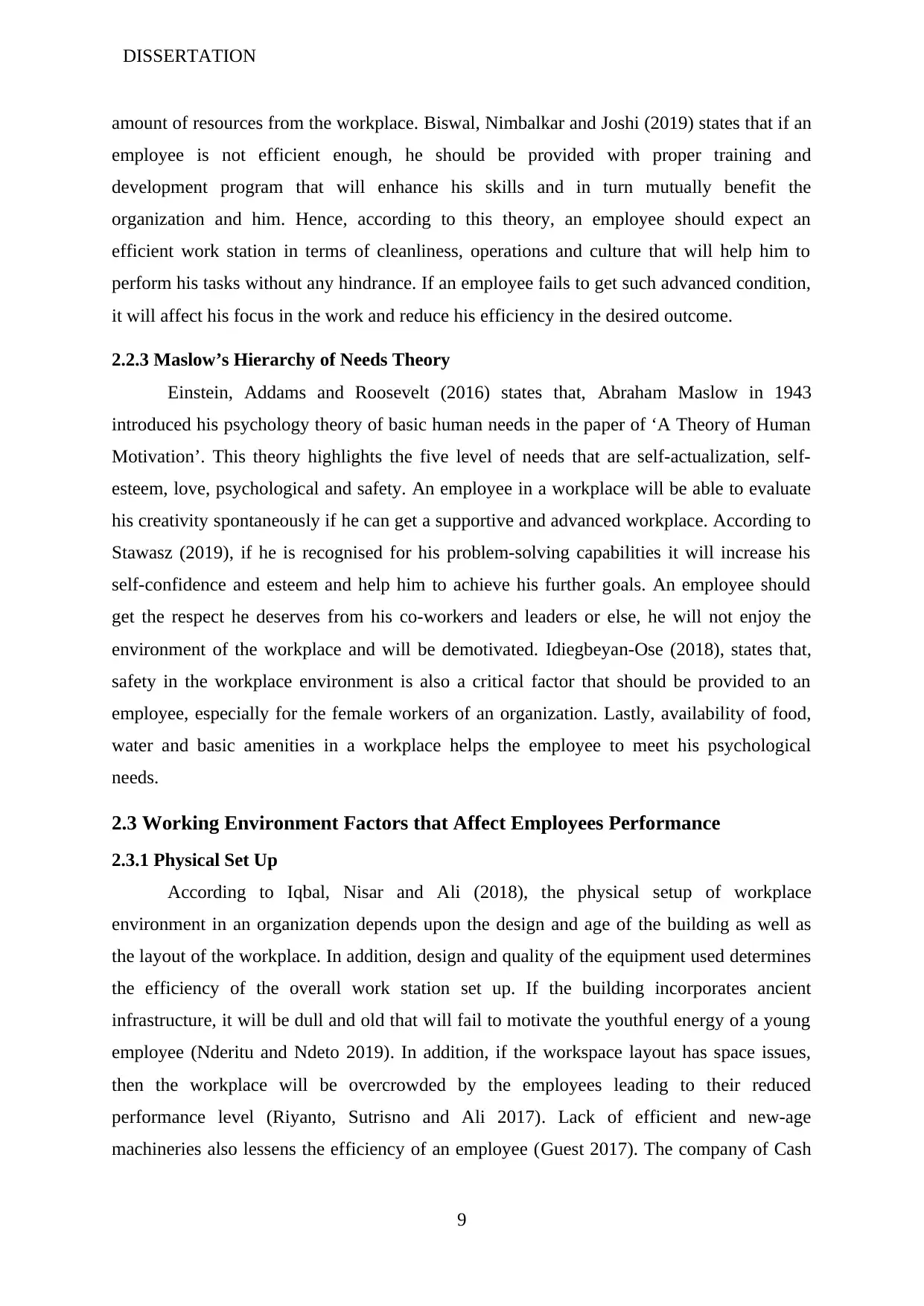
DISSERTATION
amount of resources from the workplace. Biswal, Nimbalkar and Joshi (2019) states that if an
employee is not efficient enough, he should be provided with proper training and
development program that will enhance his skills and in turn mutually benefit the
organization and him. Hence, according to this theory, an employee should expect an
efficient work station in terms of cleanliness, operations and culture that will help him to
perform his tasks without any hindrance. If an employee fails to get such advanced condition,
it will affect his focus in the work and reduce his efficiency in the desired outcome.
2.2.3 Maslow’s Hierarchy of Needs Theory
Einstein, Addams and Roosevelt (2016) states that, Abraham Maslow in 1943
introduced his psychology theory of basic human needs in the paper of ‘A Theory of Human
Motivation’. This theory highlights the five level of needs that are self-actualization, self-
esteem, love, psychological and safety. An employee in a workplace will be able to evaluate
his creativity spontaneously if he can get a supportive and advanced workplace. According to
Stawasz (2019), if he is recognised for his problem-solving capabilities it will increase his
self-confidence and esteem and help him to achieve his further goals. An employee should
get the respect he deserves from his co-workers and leaders or else, he will not enjoy the
environment of the workplace and will be demotivated. Idiegbeyan-Ose (2018), states that,
safety in the workplace environment is also a critical factor that should be provided to an
employee, especially for the female workers of an organization. Lastly, availability of food,
water and basic amenities in a workplace helps the employee to meet his psychological
needs.
2.3 Working Environment Factors that Affect Employees Performance
2.3.1 Physical Set Up
According to Iqbal, Nisar and Ali (2018), the physical setup of workplace
environment in an organization depends upon the design and age of the building as well as
the layout of the workplace. In addition, design and quality of the equipment used determines
the efficiency of the overall work station set up. If the building incorporates ancient
infrastructure, it will be dull and old that will fail to motivate the youthful energy of a young
employee (Nderitu and Ndeto 2019). In addition, if the workspace layout has space issues,
then the workplace will be overcrowded by the employees leading to their reduced
performance level (Riyanto, Sutrisno and Ali 2017). Lack of efficient and new-age
machineries also lessens the efficiency of an employee (Guest 2017). The company of Cash
9
amount of resources from the workplace. Biswal, Nimbalkar and Joshi (2019) states that if an
employee is not efficient enough, he should be provided with proper training and
development program that will enhance his skills and in turn mutually benefit the
organization and him. Hence, according to this theory, an employee should expect an
efficient work station in terms of cleanliness, operations and culture that will help him to
perform his tasks without any hindrance. If an employee fails to get such advanced condition,
it will affect his focus in the work and reduce his efficiency in the desired outcome.
2.2.3 Maslow’s Hierarchy of Needs Theory
Einstein, Addams and Roosevelt (2016) states that, Abraham Maslow in 1943
introduced his psychology theory of basic human needs in the paper of ‘A Theory of Human
Motivation’. This theory highlights the five level of needs that are self-actualization, self-
esteem, love, psychological and safety. An employee in a workplace will be able to evaluate
his creativity spontaneously if he can get a supportive and advanced workplace. According to
Stawasz (2019), if he is recognised for his problem-solving capabilities it will increase his
self-confidence and esteem and help him to achieve his further goals. An employee should
get the respect he deserves from his co-workers and leaders or else, he will not enjoy the
environment of the workplace and will be demotivated. Idiegbeyan-Ose (2018), states that,
safety in the workplace environment is also a critical factor that should be provided to an
employee, especially for the female workers of an organization. Lastly, availability of food,
water and basic amenities in a workplace helps the employee to meet his psychological
needs.
2.3 Working Environment Factors that Affect Employees Performance
2.3.1 Physical Set Up
According to Iqbal, Nisar and Ali (2018), the physical setup of workplace
environment in an organization depends upon the design and age of the building as well as
the layout of the workplace. In addition, design and quality of the equipment used determines
the efficiency of the overall work station set up. If the building incorporates ancient
infrastructure, it will be dull and old that will fail to motivate the youthful energy of a young
employee (Nderitu and Ndeto 2019). In addition, if the workspace layout has space issues,
then the workplace will be overcrowded by the employees leading to their reduced
performance level (Riyanto, Sutrisno and Ali 2017). Lack of efficient and new-age
machineries also lessens the efficiency of an employee (Guest 2017). The company of Cash
9
Paraphrase This Document
Need a fresh take? Get an instant paraphrase of this document with our AI Paraphraser
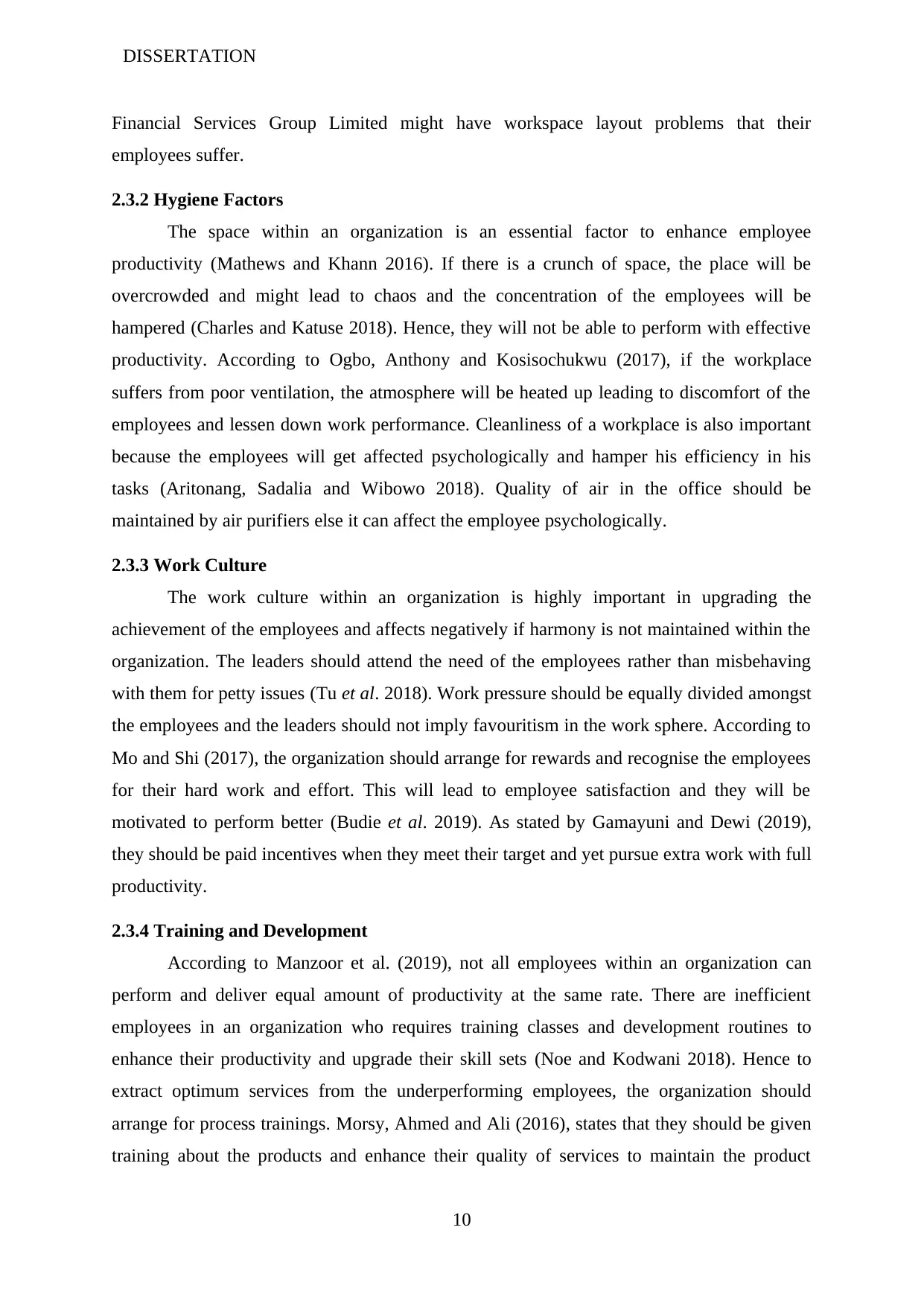
DISSERTATION
Financial Services Group Limited might have workspace layout problems that their
employees suffer.
2.3.2 Hygiene Factors
The space within an organization is an essential factor to enhance employee
productivity (Mathews and Khann 2016). If there is a crunch of space, the place will be
overcrowded and might lead to chaos and the concentration of the employees will be
hampered (Charles and Katuse 2018). Hence, they will not be able to perform with effective
productivity. According to Ogbo, Anthony and Kosisochukwu (2017), if the workplace
suffers from poor ventilation, the atmosphere will be heated up leading to discomfort of the
employees and lessen down work performance. Cleanliness of a workplace is also important
because the employees will get affected psychologically and hamper his efficiency in his
tasks (Aritonang, Sadalia and Wibowo 2018). Quality of air in the office should be
maintained by air purifiers else it can affect the employee psychologically.
2.3.3 Work Culture
The work culture within an organization is highly important in upgrading the
achievement of the employees and affects negatively if harmony is not maintained within the
organization. The leaders should attend the need of the employees rather than misbehaving
with them for petty issues (Tu et al. 2018). Work pressure should be equally divided amongst
the employees and the leaders should not imply favouritism in the work sphere. According to
Mo and Shi (2017), the organization should arrange for rewards and recognise the employees
for their hard work and effort. This will lead to employee satisfaction and they will be
motivated to perform better (Budie et al. 2019). As stated by Gamayuni and Dewi (2019),
they should be paid incentives when they meet their target and yet pursue extra work with full
productivity.
2.3.4 Training and Development
According to Manzoor et al. (2019), not all employees within an organization can
perform and deliver equal amount of productivity at the same rate. There are inefficient
employees in an organization who requires training classes and development routines to
enhance their productivity and upgrade their skill sets (Noe and Kodwani 2018). Hence to
extract optimum services from the underperforming employees, the organization should
arrange for process trainings. Morsy, Ahmed and Ali (2016), states that they should be given
training about the products and enhance their quality of services to maintain the product
10
Financial Services Group Limited might have workspace layout problems that their
employees suffer.
2.3.2 Hygiene Factors
The space within an organization is an essential factor to enhance employee
productivity (Mathews and Khann 2016). If there is a crunch of space, the place will be
overcrowded and might lead to chaos and the concentration of the employees will be
hampered (Charles and Katuse 2018). Hence, they will not be able to perform with effective
productivity. According to Ogbo, Anthony and Kosisochukwu (2017), if the workplace
suffers from poor ventilation, the atmosphere will be heated up leading to discomfort of the
employees and lessen down work performance. Cleanliness of a workplace is also important
because the employees will get affected psychologically and hamper his efficiency in his
tasks (Aritonang, Sadalia and Wibowo 2018). Quality of air in the office should be
maintained by air purifiers else it can affect the employee psychologically.
2.3.3 Work Culture
The work culture within an organization is highly important in upgrading the
achievement of the employees and affects negatively if harmony is not maintained within the
organization. The leaders should attend the need of the employees rather than misbehaving
with them for petty issues (Tu et al. 2018). Work pressure should be equally divided amongst
the employees and the leaders should not imply favouritism in the work sphere. According to
Mo and Shi (2017), the organization should arrange for rewards and recognise the employees
for their hard work and effort. This will lead to employee satisfaction and they will be
motivated to perform better (Budie et al. 2019). As stated by Gamayuni and Dewi (2019),
they should be paid incentives when they meet their target and yet pursue extra work with full
productivity.
2.3.4 Training and Development
According to Manzoor et al. (2019), not all employees within an organization can
perform and deliver equal amount of productivity at the same rate. There are inefficient
employees in an organization who requires training classes and development routines to
enhance their productivity and upgrade their skill sets (Noe and Kodwani 2018). Hence to
extract optimum services from the underperforming employees, the organization should
arrange for process trainings. Morsy, Ahmed and Ali (2016), states that they should be given
training about the products and enhance their quality of services to maintain the product
10
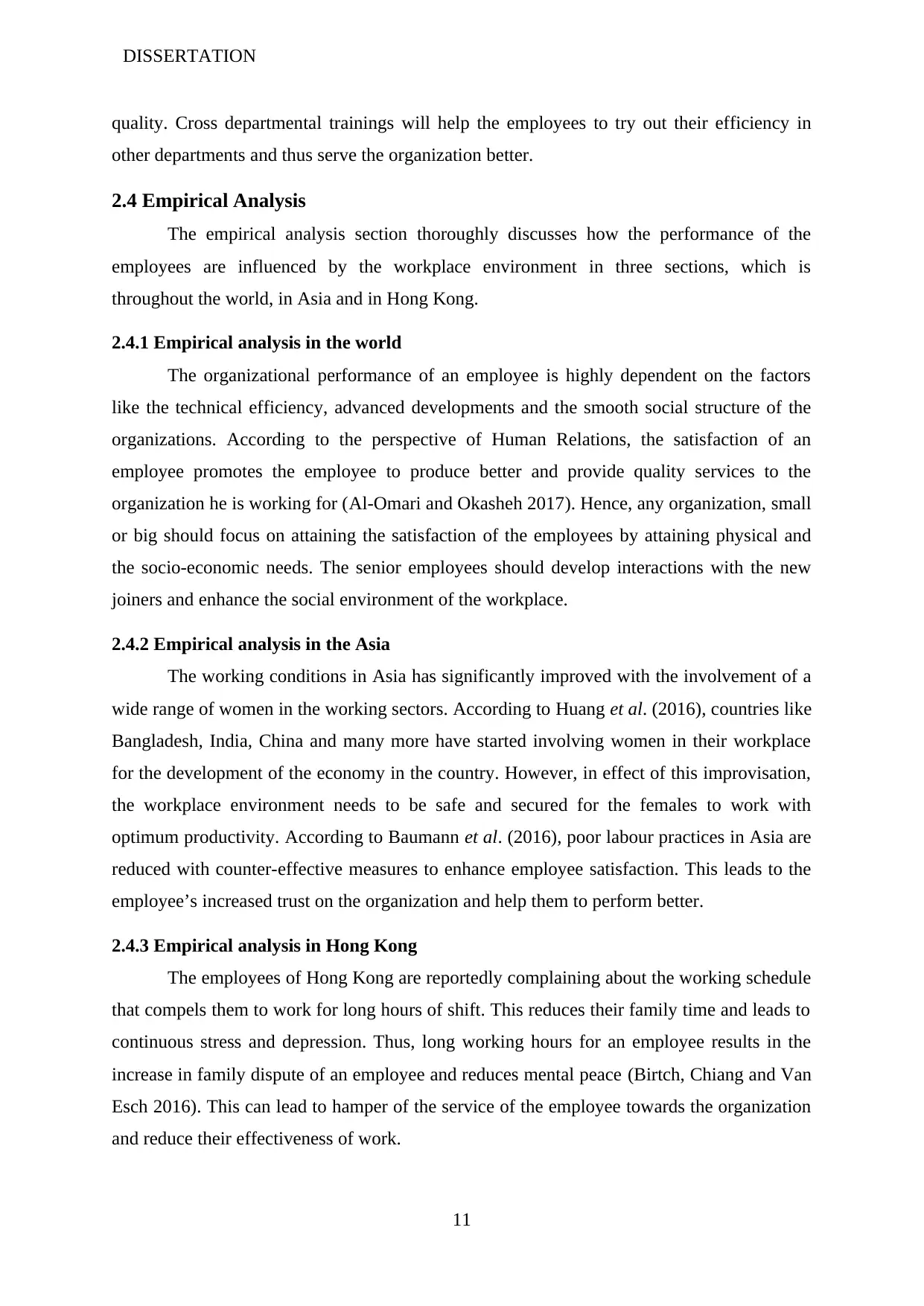
DISSERTATION
quality. Cross departmental trainings will help the employees to try out their efficiency in
other departments and thus serve the organization better.
2.4 Empirical Analysis
The empirical analysis section thoroughly discusses how the performance of the
employees are influenced by the workplace environment in three sections, which is
throughout the world, in Asia and in Hong Kong.
2.4.1 Empirical analysis in the world
The organizational performance of an employee is highly dependent on the factors
like the technical efficiency, advanced developments and the smooth social structure of the
organizations. According to the perspective of Human Relations, the satisfaction of an
employee promotes the employee to produce better and provide quality services to the
organization he is working for (Al-Omari and Okasheh 2017). Hence, any organization, small
or big should focus on attaining the satisfaction of the employees by attaining physical and
the socio-economic needs. The senior employees should develop interactions with the new
joiners and enhance the social environment of the workplace.
2.4.2 Empirical analysis in the Asia
The working conditions in Asia has significantly improved with the involvement of a
wide range of women in the working sectors. According to Huang et al. (2016), countries like
Bangladesh, India, China and many more have started involving women in their workplace
for the development of the economy in the country. However, in effect of this improvisation,
the workplace environment needs to be safe and secured for the females to work with
optimum productivity. According to Baumann et al. (2016), poor labour practices in Asia are
reduced with counter-effective measures to enhance employee satisfaction. This leads to the
employee’s increased trust on the organization and help them to perform better.
2.4.3 Empirical analysis in Hong Kong
The employees of Hong Kong are reportedly complaining about the working schedule
that compels them to work for long hours of shift. This reduces their family time and leads to
continuous stress and depression. Thus, long working hours for an employee results in the
increase in family dispute of an employee and reduces mental peace (Birtch, Chiang and Van
Esch 2016). This can lead to hamper of the service of the employee towards the organization
and reduce their effectiveness of work.
11
quality. Cross departmental trainings will help the employees to try out their efficiency in
other departments and thus serve the organization better.
2.4 Empirical Analysis
The empirical analysis section thoroughly discusses how the performance of the
employees are influenced by the workplace environment in three sections, which is
throughout the world, in Asia and in Hong Kong.
2.4.1 Empirical analysis in the world
The organizational performance of an employee is highly dependent on the factors
like the technical efficiency, advanced developments and the smooth social structure of the
organizations. According to the perspective of Human Relations, the satisfaction of an
employee promotes the employee to produce better and provide quality services to the
organization he is working for (Al-Omari and Okasheh 2017). Hence, any organization, small
or big should focus on attaining the satisfaction of the employees by attaining physical and
the socio-economic needs. The senior employees should develop interactions with the new
joiners and enhance the social environment of the workplace.
2.4.2 Empirical analysis in the Asia
The working conditions in Asia has significantly improved with the involvement of a
wide range of women in the working sectors. According to Huang et al. (2016), countries like
Bangladesh, India, China and many more have started involving women in their workplace
for the development of the economy in the country. However, in effect of this improvisation,
the workplace environment needs to be safe and secured for the females to work with
optimum productivity. According to Baumann et al. (2016), poor labour practices in Asia are
reduced with counter-effective measures to enhance employee satisfaction. This leads to the
employee’s increased trust on the organization and help them to perform better.
2.4.3 Empirical analysis in Hong Kong
The employees of Hong Kong are reportedly complaining about the working schedule
that compels them to work for long hours of shift. This reduces their family time and leads to
continuous stress and depression. Thus, long working hours for an employee results in the
increase in family dispute of an employee and reduces mental peace (Birtch, Chiang and Van
Esch 2016). This can lead to hamper of the service of the employee towards the organization
and reduce their effectiveness of work.
11
⊘ This is a preview!⊘
Do you want full access?
Subscribe today to unlock all pages.

Trusted by 1+ million students worldwide
1 out of 42
Related Documents
Your All-in-One AI-Powered Toolkit for Academic Success.
+13062052269
info@desklib.com
Available 24*7 on WhatsApp / Email
![[object Object]](/_next/static/media/star-bottom.7253800d.svg)
Unlock your academic potential
Copyright © 2020–2025 A2Z Services. All Rights Reserved. Developed and managed by ZUCOL.





